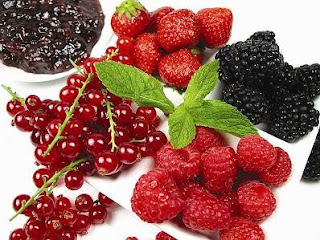 We see thousands of advertisements daily recommending oils, shampoos, conditioner and various add ones like mousse (which I always thought was only something to eat and drool over), serum and what not. But the truth has always remained simple- 'What is inside is what is reflected outside'
We see thousands of advertisements daily recommending oils, shampoos, conditioner and various add ones like mousse (which I always thought was only something to eat and drool over), serum and what not. But the truth has always remained simple- 'What is inside is what is reflected outside'As kids we were always forced to eat right…and now that we wishfully want to do so, our social circuit kind of goes against it. This blog is created to make all those fitness freaks realise that they are not alone in this battle. Read On for some relatable articles and some doable diets.
Monday, December 28, 2009
Food For Hair
 We see thousands of advertisements daily recommending oils, shampoos, conditioner and various add ones like mousse (which I always thought was only something to eat and drool over), serum and what not. But the truth has always remained simple- 'What is inside is what is reflected outside'
We see thousands of advertisements daily recommending oils, shampoos, conditioner and various add ones like mousse (which I always thought was only something to eat and drool over), serum and what not. But the truth has always remained simple- 'What is inside is what is reflected outside'Monday, December 21, 2009
Some Facts...With A Twist!

Good habits are like wine...the more older..the stronger. But somehow we all feel that bad habits are more addictive! Was just thinking about some habits of ours and some bitter facts behind them.Try to take them with a pinch of salt, if they hurt real bad! Here they go.
People Burp....not because they don't have etiquettes!
…but because they eat too fast. Gulping down food without chewing it properly does not engage saliva causing poor digestion. You take in excess air which can lead to bloating and burping, which we think is an ugly habit!
Your stomach is not a dumping ground!
Overeating leads to obesity, CV disease and other lifestyle diseases which we all are aware of. But overeating also leads to production of toxins in the body. Lifelong overeating can lead to excessive toxin production and accumulation which will result to colon diseases.
Feed your body not your emotions!
A stressful day in the office, a breakup with the loved one, or a simply bad day doesn’t give you the privilege to binge on that calorie loaded huge bar of chocolate.Binge eaters report more health issues like stress, insomnia, and not to mention drastic weight gain.
When nature calls, answer before it’s too late!
Not listening to natures call on time puts extra load on your system, specially your vital organs like kidney and intestines.
Killer Practice: Self medication!
God made doctors for a reason. Keep them employed please! Self prescription of medicines even if it’s just a crocin can be fatal at times.
Faking can be beneficial!
Faking that you are full and satiated the is!.sometimes it’s all in the mind that you tend to feel hungry at the sight of food. If you have a tendency to eat mindlessly, it’s better to overlook such signs and tell yourself that you are full and happy1
If you think you’ll live longer…maybe you will!
Researches show that optimistic people are 14% less likely to die due to illness as compared to pessimists. Also they are 30%less likely to die of heart disease.
So think again what wrong are you doing and start talking a different route to life!
Monday, December 14, 2009
Good Skin- The secret is Your Refrigerator!
 The simplest ways to get gorgeous may just be lying in your refrigerator.Get some healthy food to get healthy skin back:
The simplest ways to get gorgeous may just be lying in your refrigerator.Get some healthy food to get healthy skin back: WALNUTS:
Saturday, December 5, 2009
What are functional foods?


The concept of functional foods was born in Japan. In the 1980s, health authorities in Japan recognised that an improved quality of life must accompany increasing life expectancy for the expanding number of elderly people in the population if health care costs were to be controlled. The concept of foods that were developed specifically to promote health or reduce the risk of disease was introduced. Functional foods, generally, are considered as those foods which are intended to be consumed as part of the normal diet and that contain biologically active components which offer the potential of enhanced health or reduced risk of disease. Examples of functional foods include foods that contain specific minerals, vitamins, fatty acids or dietary fiber, foods with added biologically active substances such as phytochemicals or other antioxidants and probiotics that have live beneficial cultures . As interest in this category of foods has grown, new products have appeared and interest has turned to the development of standards and guidelines for the development and promotion of such foods.
Why do we need functional foods?
Consumer interest in the relationship between diet and health has increased substantially. There is much greater recognition today that people can help themselves and their families to reduce the risk of illness and disease and to maintain their state of health and well being through a healthy lifestyle, including the diet. Ongoing support for the important role of foods such as fruits and vegetables and wholegrain cereals in disease prevention and the latest research on dietary antioxidants and combinations of protective substances in plants has helped to provide the impetus for further developments in the functional food market .Trends in population demographics and socio-economic changes also point to the need for foods with added health benefits. An increase in life expectancy, resulting in an increase in the number of elderly and the desire for an improved quality of life, as well as increasing costs of health care, have stimulated governments, researchers, health professionals and the food industry to see how these changes can be managed more effectively. There is already a wide range of foods available to today's consumer but now the impetus is to identify those functional foods that have the potential to improve health and well-being, reduce the risk from, or delay the onset of, major diseases such as cardiovascular disease (CVD), cancer and osteoporosis. Combined with a healthy lifestyle, functional foods can make a positive contribution to health and well being.